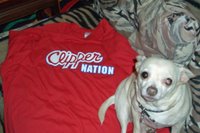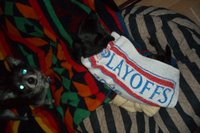
Tuesday, May 30, 2006
Feels Like a Monday
A bit of progress here... bit more here ...not much progress here...but nothing too substantial.
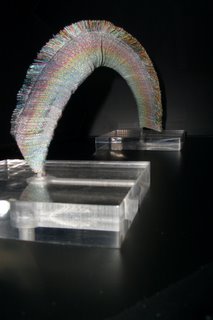 Today's project is to prepare my piece which was accepted for the Celebrations Exhibit for mailing to Grand Rapids. Perhaps I can also make more progress on one or moreof those other projects.
Today's project is to prepare my piece which was accepted for the Celebrations Exhibit for mailing to Grand Rapids. Perhaps I can also make more progress on one or moreof those other projects.
This piece is called Rainbow over Anegada. It reminds me of the rainbow we saw as we sailed into the harbor at Anegada last New Years just before a light rain. It was a 'High Minor' moment...calm, quiet, tranquil, and peaceful.
The reality was somewhat like this...look at the last photo at the bottom of that page.
I will try to hunt up a copy of my photo which is a similar shot but with a slightly different atmosphere.
 Today's project is to prepare my piece which was accepted for the Celebrations Exhibit for mailing to Grand Rapids. Perhaps I can also make more progress on one or moreof those other projects.
Today's project is to prepare my piece which was accepted for the Celebrations Exhibit for mailing to Grand Rapids. Perhaps I can also make more progress on one or moreof those other projects.This piece is called Rainbow over Anegada. It reminds me of the rainbow we saw as we sailed into the harbor at Anegada last New Years just before a light rain. It was a 'High Minor' moment...calm, quiet, tranquil, and peaceful.
The reality was somewhat like this...look at the last photo at the bottom of that page.
I will try to hunt up a copy of my photo which is a similar shot but with a slightly different atmosphere.
Friday, May 26, 2006
Mor[s]e I-Cords
I thought it might be fun to knit my name in morse code on an I-cord and have it hang on my sculpture [which is still in the conceptual stage.]

How well do you know your morse code?
A dot is one unit, a dash is three units and there is a space between letters equal to one unit. I tried to make it even easier to read by alternatating the colors of each letter. I used two different shades of red...which you may notice did not turn out pastel pink as my reds tend to do.
Don't remember your morse code? Here's a link for a cheat sheet.
For my I-cords one unit turned out to be about a foot. I tied the fifty foot skein at each dot, dash and space. I even used different colored yarn to indicate which spots should be which color. Like in construction I measured twice and cut once...so I checked my plan twice and dyed once. Unfortunately I made a couple of small errors - one where I tied off one piece of yarn and another in the choice of color of yarn... and small errors do not make a spelling bee champion.
Next time I may follow my friend's suggestion of simply knitting the I-cord and dyeing the cord afterwards. Easier and less messy. But the knitting will be so boring unless I use some variegated yarn. Perhaps some of those leftovers from Dye Day will just do the trick.
ps.
If you work through the message in the picture you will get something like NAKARAK or KARAKAN depending upon which direction you read the I-cord. Neither is my name.

How well do you know your morse code?
A dot is one unit, a dash is three units and there is a space between letters equal to one unit. I tried to make it even easier to read by alternatating the colors of each letter. I used two different shades of red...which you may notice did not turn out pastel pink as my reds tend to do.
Don't remember your morse code? Here's a link for a cheat sheet.
For my I-cords one unit turned out to be about a foot. I tied the fifty foot skein at each dot, dash and space. I even used different colored yarn to indicate which spots should be which color. Like in construction I measured twice and cut once...so I checked my plan twice and dyed once. Unfortunately I made a couple of small errors - one where I tied off one piece of yarn and another in the choice of color of yarn... and small errors do not make a spelling bee champion.
Next time I may follow my friend's suggestion of simply knitting the I-cord and dyeing the cord afterwards. Easier and less messy. But the knitting will be so boring unless I use some variegated yarn. Perhaps some of those leftovers from Dye Day will just do the trick.
ps.
If you work through the message in the picture you will get something like NAKARAK or KARAKAN depending upon which direction you read the I-cord. Neither is my name.
Thursday, May 25, 2006
Yarn to Dye & Knit
I wanted to dye some yarn which would go from light to dark and try it out in some shadow knitting to see if I actually like the shadow knitting technique. I really need a scarf that I can wear with blue jeans. No scarf I have woven, knitted or bought has any blue in it. Well...there is one...but it is wool - - woven before I realized I was allergic to wool.
Before our Group Dye Day, I spent a morning 'honing' my dye technique. I described the technique for dyeing a ball of yarn in the middle of a previous blog. I used procion dye since my yarn was a blend of cotton and modal. I followed the technique described in the Yarn to Dye For book by Kathleen Taylor adjusting for the fact that I was using a dye for cellusose fibers and not wool. The basic method is to soak a loose ball of yarn in soda ash and then drop it into the dye. Every five minutes about five yards are pulled out. Obviously, it was messy - quite messy. And my results were not great...I had very little graduation on my first experiment and lots of the dye washed out. Plus, my two different reds turned out a pastel pink...
For Dye Day, I modified my technique a bit. I soaked the dye longer in soda ash and made some extra dye to boost the color after forty minutes. Plus, instead of red I tried a wedgewood blue and a seafoam green. The results were better. I did get some graduation. When pulling the yarn out of the dye, I ran it through my fingers to get all the dye out and laid it carefully in a plastic container. I then, let it sit for a day to cure and dry. Once dry I donned my plastic gloves and skeined the yarn, rinsed out the dye, dried it and balled it all up. This experiment turned out a bit better but I will need to knit it up to see how the graduation really shows up.
I wanted to try knitting a diagonal scarf - the ones where you add a stitch on one side and decrease on the other side. I like how they hang and have never done one that way. I planned to have the shadow stripes go diagonally up the scarf. I've started the knitting a couple of times to get the shadow stripes going in the 'right' direction. I think it's working now.
 Here's a picture of the yarn and the first few inches of knitting. From this angle, you can see the stripes going diagonally up the scarf - - I am not sure how obvious these stripes will be when worn. I'll post another photo when I get further. Too bad I can't post the actual feel of the piece - - it is soft and smooth yarn which has a great feel and the texture from the ridges make it even better.
Here's a picture of the yarn and the first few inches of knitting. From this angle, you can see the stripes going diagonally up the scarf - - I am not sure how obvious these stripes will be when worn. I'll post another photo when I get further. Too bad I can't post the actual feel of the piece - - it is soft and smooth yarn which has a great feel and the texture from the ridges make it even better.
You will note that I also had a couple of extra lighter blue & off white balls there. Those are the extra ones I made a few days after Dye Day when a call went out that there was dye left over and would anyone be interested... I figured - why waste the dye! I didn't think I had enough yarn to finish one scarf so I handpainted a skein or two with a variegated pattern in that wedgewood blue. Now I will have more than enough yarn. Using this different pattern on the other half of the scarf should add visual interest.
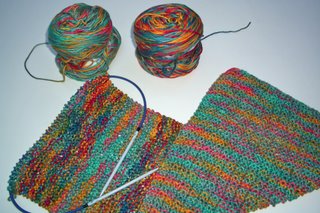 I also handpainted a few other skeins with the left overs...it had that tie-dyed look when I finished painting. Interestingly and not planned, the two skeins go well together. One is darker than the other. I am knitting the two using seed stitch so I can knit while watching TV or listening to folks talk in meetings. I like how it is coming out.
I also handpainted a few other skeins with the left overs...it had that tie-dyed look when I finished painting. Interestingly and not planned, the two skeins go well together. One is darker than the other. I am knitting the two using seed stitch so I can knit while watching TV or listening to folks talk in meetings. I like how it is coming out.
This too may go with blue jeans...
Before our Group Dye Day, I spent a morning 'honing' my dye technique. I described the technique for dyeing a ball of yarn in the middle of a previous blog. I used procion dye since my yarn was a blend of cotton and modal. I followed the technique described in the Yarn to Dye For book by Kathleen Taylor adjusting for the fact that I was using a dye for cellusose fibers and not wool. The basic method is to soak a loose ball of yarn in soda ash and then drop it into the dye. Every five minutes about five yards are pulled out. Obviously, it was messy - quite messy. And my results were not great...I had very little graduation on my first experiment and lots of the dye washed out. Plus, my two different reds turned out a pastel pink...
For Dye Day, I modified my technique a bit. I soaked the dye longer in soda ash and made some extra dye to boost the color after forty minutes. Plus, instead of red I tried a wedgewood blue and a seafoam green. The results were better. I did get some graduation. When pulling the yarn out of the dye, I ran it through my fingers to get all the dye out and laid it carefully in a plastic container. I then, let it sit for a day to cure and dry. Once dry I donned my plastic gloves and skeined the yarn, rinsed out the dye, dried it and balled it all up. This experiment turned out a bit better but I will need to knit it up to see how the graduation really shows up.
I wanted to try knitting a diagonal scarf - the ones where you add a stitch on one side and decrease on the other side. I like how they hang and have never done one that way. I planned to have the shadow stripes go diagonally up the scarf. I've started the knitting a couple of times to get the shadow stripes going in the 'right' direction. I think it's working now.
 Here's a picture of the yarn and the first few inches of knitting. From this angle, you can see the stripes going diagonally up the scarf - - I am not sure how obvious these stripes will be when worn. I'll post another photo when I get further. Too bad I can't post the actual feel of the piece - - it is soft and smooth yarn which has a great feel and the texture from the ridges make it even better.
Here's a picture of the yarn and the first few inches of knitting. From this angle, you can see the stripes going diagonally up the scarf - - I am not sure how obvious these stripes will be when worn. I'll post another photo when I get further. Too bad I can't post the actual feel of the piece - - it is soft and smooth yarn which has a great feel and the texture from the ridges make it even better.You will note that I also had a couple of extra lighter blue & off white balls there. Those are the extra ones I made a few days after Dye Day when a call went out that there was dye left over and would anyone be interested... I figured - why waste the dye! I didn't think I had enough yarn to finish one scarf so I handpainted a skein or two with a variegated pattern in that wedgewood blue. Now I will have more than enough yarn. Using this different pattern on the other half of the scarf should add visual interest.
 I also handpainted a few other skeins with the left overs...it had that tie-dyed look when I finished painting. Interestingly and not planned, the two skeins go well together. One is darker than the other. I am knitting the two using seed stitch so I can knit while watching TV or listening to folks talk in meetings. I like how it is coming out.
I also handpainted a few other skeins with the left overs...it had that tie-dyed look when I finished painting. Interestingly and not planned, the two skeins go well together. One is darker than the other. I am knitting the two using seed stitch so I can knit while watching TV or listening to folks talk in meetings. I like how it is coming out.This too may go with blue jeans...
Wednesday, May 24, 2006
No Inspiration Here
 Let's see what else have I done lately...oh yes... our Group did have another dye day so I now have lots of dyed yarn for some knitting experiments.
Let's see what else have I done lately...oh yes... our Group did have another dye day so I now have lots of dyed yarn for some knitting experiments.Remember how I wanted some interesting I-cords for a woven sculpture I am contemplating? Well, I have tried the four dyed yarns I dyed last month and so far I have found no inspiration from any of them. I did determine I like the cords using the size 3 needles. I stopped knitting those cords and am now using up the rest of the yarn for a variety of experiments - currently crocheted hyperbolic planes.
Next I'll show how my morse code experiment came out.
More later....
PS I just finished a 'happy' high major in my value study...go here to read more.
Time Flies!
My, my, my where did the time go...it seems like ages since I blogged last and I have been doing such interesting things too!
I just mailed off nineteen bookmarks for our bookmark exchange. Boy, that finishing took quite awhile...given that I made three sets of each bookmark...let's see that's 57 bookmarks; you can understand why it took so long. Plus, I got a serger and got to play with that for a couple of days before I serged the ends of the bookmarks.
Here's a picture of the bookmarks I did not send to this bookmark exchange. I kept one set for my records. So for each pattern I designed I will now have an actual example of what the woven beetle looks like. Plus, all the different color combinations are a good indication of what happens to various colors when used together. The second set is for friends and family...or perhaps the [another] upcoming bookmark exchange. Although, I am contemplating another idea for that next exchange....
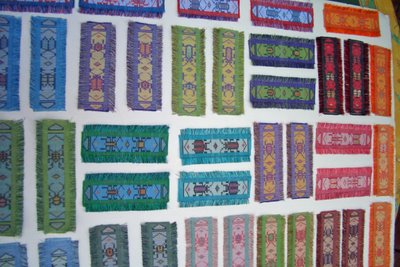
I just mailed off nineteen bookmarks for our bookmark exchange. Boy, that finishing took quite awhile...given that I made three sets of each bookmark...let's see that's 57 bookmarks; you can understand why it took so long. Plus, I got a serger and got to play with that for a couple of days before I serged the ends of the bookmarks.
Here's a picture of the bookmarks I did not send to this bookmark exchange. I kept one set for my records. So for each pattern I designed I will now have an actual example of what the woven beetle looks like. Plus, all the different color combinations are a good indication of what happens to various colors when used together. The second set is for friends and family...or perhaps the [another] upcoming bookmark exchange. Although, I am contemplating another idea for that next exchange....

Saturday, May 13, 2006
Thursday, May 11, 2006
Another Hyperbolic Plane
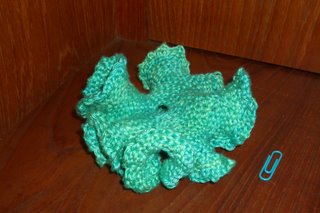
Here is another hyperbolic plane...this one started with a circle of twelve chain stitches and then I increased one every third crochet stitch.
I used that dyed 3/2 pearl cotton I had left over and a 0/3.25 mm crochet hook.
It never ceases to amaze me at how quickly and how long the outside gets. This one is forty five inches around the outside circumference.
Friday, May 05, 2006
A Value Scale for Fiber
Each medium, whether it be photography, paint, watercolor or fiber - each has its own value scale. Part of my Value Study is to develop the actual value scale for the yarns that I use in my tapestry.
What we actually see in nature is the maximum value scale. But with other mediums the value scale is compressed. In my yarns, my whites are not the pure white you see in nature. Nor are my blacks pure black. They cannot be made in yarn. In addition, due to the texture of yarns the shadows distort the values depending upon where the light is coming from.
I need to develop a value scale that will depict nature as close as possible given this compression of values due to the nature of the fiber. Somehow this 'ideal range' of natural color must be squeezed into this smaller range for fiber. By doing this, my colors will appear more natural and accurate to the viewer.
My scale will have nine categories. There must be a perceptual interval change and each should seem half way between its neighbors. The mid-value should be roughly between the darkest and lightest values.
So far, I have worked diligently to get the yarns in the best value order that I can. The pictures are below. This took awhile, because the values had to line up in value order based on what they looked like woven, not on bobbins or in balls. It's pretty easy to see if something is mid-value or light. It is harder to determine the distinctions between two categories next to each other or for yarns within the same category. You may remember a similar picture...this is my second attempt - better results plus I added more yarns to fill out my spectrum.
I have also taken a first stab at putting them into the nine value categories that I plan to use. The scale was developed by Denman Ross in 1907 and uses descriptive phrases to identify each category verses other scales that use numbers or percentages. I find this easier to use and remember. If you would like to read more about the scale and the High Minor Key - click here.


What we actually see in nature is the maximum value scale. But with other mediums the value scale is compressed. In my yarns, my whites are not the pure white you see in nature. Nor are my blacks pure black. They cannot be made in yarn. In addition, due to the texture of yarns the shadows distort the values depending upon where the light is coming from.
I need to develop a value scale that will depict nature as close as possible given this compression of values due to the nature of the fiber. Somehow this 'ideal range' of natural color must be squeezed into this smaller range for fiber. By doing this, my colors will appear more natural and accurate to the viewer.
My scale will have nine categories. There must be a perceptual interval change and each should seem half way between its neighbors. The mid-value should be roughly between the darkest and lightest values.
So far, I have worked diligently to get the yarns in the best value order that I can. The pictures are below. This took awhile, because the values had to line up in value order based on what they looked like woven, not on bobbins or in balls. It's pretty easy to see if something is mid-value or light. It is harder to determine the distinctions between two categories next to each other or for yarns within the same category. You may remember a similar picture...this is my second attempt - better results plus I added more yarns to fill out my spectrum.
I have also taken a first stab at putting them into the nine value categories that I plan to use. The scale was developed by Denman Ross in 1907 and uses descriptive phrases to identify each category verses other scales that use numbers or percentages. I find this easier to use and remember. If you would like to read more about the scale and the High Minor Key - click here.


Wednesday, May 03, 2006
Value Re-Visited
A follow-up on the odd result in the Color Works book which I blogged about a couple of days ago. I re-ordered the strips in the value order I think they should be in. A blue and a green moved up [darker] in value both by two levels. The others were close enough. I figure there is some distortion due to the printing as well as the shiny texture of the book pages.
The resulting spectrum of colors has a result is similar to this chart. The chart has more colors and I find it quite fascinating. The chart shows various colors with the warm colors on the left and cool colors on the right. Along the vertical axis is the value - with the lighter values on top and the darker values on the bottom. This clearly illustrates that different colors have their lowest value and highest value starting and ending in different positions along the scale.
A further update:
I just took all my yarn in value categories and split them between the warms and the cools. I wanted to see how they looked in a spectrum similar to that above. Here it is...

The resulting spectrum of colors has a result is similar to this chart. The chart has more colors and I find it quite fascinating. The chart shows various colors with the warm colors on the left and cool colors on the right. Along the vertical axis is the value - with the lighter values on top and the darker values on the bottom. This clearly illustrates that different colors have their lowest value and highest value starting and ending in different positions along the scale.
A further update:
I just took all my yarn in value categories and split them between the warms and the cools. I wanted to see how they looked in a spectrum similar to that above. Here it is...

My Pseudosphere

My first stab at a Hyperbolic Plane: Started with some self-dyed patterned yarn...Crocheted a circle...and started increasing...it is about five inches wide...hard to believe but the outside edge is over twelve feet long...reminds me a bit of coral...but more like this.
Tuesday, May 02, 2006
A Week of Value
 I worked quite diligently last week on trying to get a handle on value in the tapestry context. Quite a frustrating week. After reviewing my first experiment in a low minor value I decided I had better take a step back and dig deeper into the value of my tapestry yarns. That turned out to be much harder than it had seemed. As I understand it, the human eye can only perceive a limited number of differences in value. So trying to lay out each piece of yarn in value order is problematic. This photo on the left is my first attempt at lining up the colors in value order.
I worked quite diligently last week on trying to get a handle on value in the tapestry context. Quite a frustrating week. After reviewing my first experiment in a low minor value I decided I had better take a step back and dig deeper into the value of my tapestry yarns. That turned out to be much harder than it had seemed. As I understand it, the human eye can only perceive a limited number of differences in value. So trying to lay out each piece of yarn in value order is problematic. This photo on the left is my first attempt at lining up the colors in value order.There are a number of ways to determine the relative value of things besides just looking at the yarn. There is the quick and dirty 'squinting' method, you could make a black and white copy of the piece, if you are a quilter you could use one of those ruby beholders. My favorite is simply using the black and white mode of a digital camera.
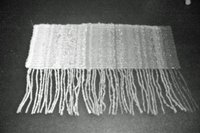 I had originally divided up the yarn into categories by looking through my camera in black and white mode at the yarn wound up on small bobbins. This was a bit confusing since I got slightly different results based on the time of day and the nature of the surrounding light. I also got different results when I looked at the balls of yarn vs. the bobbins. In my frustration, I reminded myself why I am doing this...I want to understand value in the tapestry context. So, I decided to weave a panel with a bit of each yarn in value order so I could see how the results looked woven. I wanted a gray scale of my yarns. You can see the result in color and in black & white mode - - many of the colors looked out of order - some way out of order.
I had originally divided up the yarn into categories by looking through my camera in black and white mode at the yarn wound up on small bobbins. This was a bit confusing since I got slightly different results based on the time of day and the nature of the surrounding light. I also got different results when I looked at the balls of yarn vs. the bobbins. In my frustration, I reminded myself why I am doing this...I want to understand value in the tapestry context. So, I decided to weave a panel with a bit of each yarn in value order so I could see how the results looked woven. I wanted a gray scale of my yarns. You can see the result in color and in black & white mode - - many of the colors looked out of order - some way out of order.And to make it even more confusing - - the order seemed different based on what method I used to determine the relative value. The black and white copy looked different that the digital camera. The Rudy Beholder gave a way different result. Squinting made it difficult to compare two adjacent colors since I only wove less than a yard of each color. I tried each method and compared the gray I saw with the gray from my Color-aid strips. Wow! I had figured the shade of gray would be different based on the method I chose. I did not think the relative values would also be different. What a surprise!
And to make things really interesting...take a look at these two photos from Color Works by Deb Menz, one of the books I am using for this study of Value.
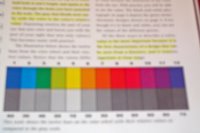 The first picture on the left shows the color spectrum with the gray scale below. The point illustrated is that different colors have different values and they do not progress uniformly along the color spectrum.
The first picture on the left shows the color spectrum with the gray scale below. The point illustrated is that different colors have different values and they do not progress uniformly along the color spectrum.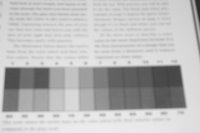
But then look at the picture of the page I took in black and white mode. It paints quite a different picture of the relative values - particularly those cool blues and green on the left. The results of the book would put the first blue on the left as the same value as the red. The results from the black and white mode of my digital camera would place that blue closer to the blue on the right.
If I go into a dimly lit room and squint at the colors in the book - the warm colors look close in value to the gray scale but the cooler colors look a bit off...but not as off as in the photos. If you own the book - go try it.
I understand some of the reasons for this but not all. More later.
Monday, May 01, 2006
Hyperbolic Planes
I took a nice break from my frustrations with value...I went to a workshop on hyperbolic planes given by Margaret Wertheim from the Institute for Figuring. It was given at a nice knitting shop; That Yarn Store, in Eagle Rock - never been to Eagle Rock - but it turned out to be a fairly cute little town on the way to Pasadena. Apparently the town was named after a rock which has a shadow of an eagle on it when the sun shines on it in a certain way.
It's pretty easy to understand parallel lines on a flat surface. It's gets a bit more complex to understand parallel lines on a sphere - reminded me of my celestial navigation days. But it's near impossible to imagine parallel lines on a hyperbolic plane - unless you know how to crochet. It is quite fascinating that it took a Latvian women who could crochet to finally in 1997 provide mathematicians with a way to actually touch and feel hyperbolic planes. Here is a photo of the some of the crocheted hyperbolic planes that Margaret had made. There are more on the website for the Institute of Figuring. There are some here and here and more here!
 I took this picture to go with my notes that I took to document how to make each one of these different pieces. Fortunately, Margaret had also brought some copies of her book, A Field Guild to Hyperbolic Space; An Exploration of the Intersection of Higher Geometry and Feminine Handicraft. A nice compact book with the mathematical history and background of hyperbolic planes plus pictures and instructions on how to make the many kinds. I bought one. I couldn't resist. The book has the instructions and black and white photos. Colored ones are on the website.
I took this picture to go with my notes that I took to document how to make each one of these different pieces. Fortunately, Margaret had also brought some copies of her book, A Field Guild to Hyperbolic Space; An Exploration of the Intersection of Higher Geometry and Feminine Handicraft. A nice compact book with the mathematical history and background of hyperbolic planes plus pictures and instructions on how to make the many kinds. I bought one. I couldn't resist. The book has the instructions and black and white photos. Colored ones are on the website.
I really liked what is called a pseudosphere which is made by crocheting in a spiral pattern then increasing by one stitch every three until you run out of yarn or get bored. Here is a picture of a pink pseudosphere.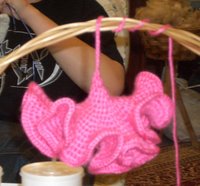 A pseudosphere is a hyperbolic plane which is wrapped around a cone point. I am currently crocheting one with my hand dyed self patterning yarn which is green with some yellow patches. I will post a photo when I am done...I have about five more rows to go - each row is doubling in size so it takes longer and longer to make one pass around. It's great to do while watching TV - - much easier than knitting - - and much more fun. [I obviously have not yet turned into a knitting knut...] I think I may try dyeing some yarn that would generate a better pattern and a unique look for this type of structure.
A pseudosphere is a hyperbolic plane which is wrapped around a cone point. I am currently crocheting one with my hand dyed self patterning yarn which is green with some yellow patches. I will post a photo when I am done...I have about five more rows to go - each row is doubling in size so it takes longer and longer to make one pass around. It's great to do while watching TV - - much easier than knitting - - and much more fun. [I obviously have not yet turned into a knitting knut...] I think I may try dyeing some yarn that would generate a better pattern and a unique look for this type of structure.
The Institute is putting together a display of a Coral Reef made of these crocheted hyperbolic planes. Perhaps, if one of mine comes out good, I'll send them one for their Coral Reef.
It's pretty easy to understand parallel lines on a flat surface. It's gets a bit more complex to understand parallel lines on a sphere - reminded me of my celestial navigation days. But it's near impossible to imagine parallel lines on a hyperbolic plane - unless you know how to crochet. It is quite fascinating that it took a Latvian women who could crochet to finally in 1997 provide mathematicians with a way to actually touch and feel hyperbolic planes. Here is a photo of the some of the crocheted hyperbolic planes that Margaret had made. There are more on the website for the Institute of Figuring. There are some here and here and more here!
 I took this picture to go with my notes that I took to document how to make each one of these different pieces. Fortunately, Margaret had also brought some copies of her book, A Field Guild to Hyperbolic Space; An Exploration of the Intersection of Higher Geometry and Feminine Handicraft. A nice compact book with the mathematical history and background of hyperbolic planes plus pictures and instructions on how to make the many kinds. I bought one. I couldn't resist. The book has the instructions and black and white photos. Colored ones are on the website.
I took this picture to go with my notes that I took to document how to make each one of these different pieces. Fortunately, Margaret had also brought some copies of her book, A Field Guild to Hyperbolic Space; An Exploration of the Intersection of Higher Geometry and Feminine Handicraft. A nice compact book with the mathematical history and background of hyperbolic planes plus pictures and instructions on how to make the many kinds. I bought one. I couldn't resist. The book has the instructions and black and white photos. Colored ones are on the website.I really liked what is called a pseudosphere which is made by crocheting in a spiral pattern then increasing by one stitch every three until you run out of yarn or get bored. Here is a picture of a pink pseudosphere.
 A pseudosphere is a hyperbolic plane which is wrapped around a cone point. I am currently crocheting one with my hand dyed self patterning yarn which is green with some yellow patches. I will post a photo when I am done...I have about five more rows to go - each row is doubling in size so it takes longer and longer to make one pass around. It's great to do while watching TV - - much easier than knitting - - and much more fun. [I obviously have not yet turned into a knitting knut...] I think I may try dyeing some yarn that would generate a better pattern and a unique look for this type of structure.
A pseudosphere is a hyperbolic plane which is wrapped around a cone point. I am currently crocheting one with my hand dyed self patterning yarn which is green with some yellow patches. I will post a photo when I am done...I have about five more rows to go - each row is doubling in size so it takes longer and longer to make one pass around. It's great to do while watching TV - - much easier than knitting - - and much more fun. [I obviously have not yet turned into a knitting knut...] I think I may try dyeing some yarn that would generate a better pattern and a unique look for this type of structure.The Institute is putting together a display of a Coral Reef made of these crocheted hyperbolic planes. Perhaps, if one of mine comes out good, I'll send them one for their Coral Reef.
Subscribe to:
Posts (Atom)
